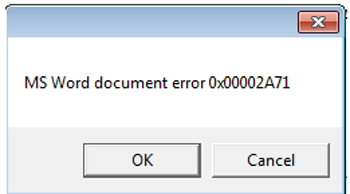Worm.JS.DLOADR.AA
JS/TrojanDownloader.Agent.TRX (ESET-Nod32) ; JS/Agent.TRX!tr.dldr (Fortinet)
Windows


Threat Type: Worm
Destructiveness: No
Encrypted:
In the wild: Yes
OVERVIEW
This Worm arrives on a system as a file dropped by other malware or as a file downloaded unknowingly by users when visiting malicious sites.
It executes the downloaded files. As a result, malicious routines of the downloaded files are exhibited on the affected system.
TECHNICAL DETAILS
Arrival Details
This Worm arrives on a system as a file dropped by other malware or as a file downloaded unknowingly by users when visiting malicious sites.
Installation
This Worm drops the following files:
- %User Temp%\{Random Numbers}.cro -> Encrypted executable
- %User Temp%\{Random Numbers}.exe -> Decrypted executable
(Note: %User Temp% is the current user's Temp folder, which is usually C:\Documents and Settings\{user name}\Local Settings\Temp on Windows 2000(32-bit), XP, and Server 2003(32-bit), or C:\Users\{user name}\AppData\Local\Temp on Windows Vista, 7, 8, 8.1, 2008(64-bit), 2012(64-bit) and 10(64-bit).)
It adds the following processes:
- cmd /U /Q /C cd /D
: && dir /b/s/x *.doc *.xls *.pdf *.rtf *.txt *.pub *.odt *.ods *.odp *.odm *.odc *.odb >> %TEMP%\ascii.txt - cmd /U /Q /C copy /Y "{Malware File Directory}\{Malware File Name}" "{Name of the File it will replace}.jse && del /Q/F {Name of the File it will replace}"
- certutil.exe -decode %User Temp%\{Random Number}.cro %User Temp%\{Random Number}.exe
- %User Temp%\{Random Number}.exe
(Note: %User Temp% is the current user's Temp folder, which is usually C:\Documents and Settings\{user name}\Local Settings\Temp on Windows 2000(32-bit), XP, and Server 2003(32-bit), or C:\Users\{user name}\AppData\Local\Temp on Windows Vista, 7, 8, 8.1, 2008(64-bit), 2012(64-bit) and 10(64-bit).)
It displays the following fake error messages:

Autostart Technique
This Worm drops the following file(s) in the Windows User Startup folder to enable its automatic execution at every system startup:
- %User Startup%\shell.jse
(Note: %User Startup% is the current user's Startup folder, which is usually C:\Windows\Profiles\{user name}\Start Menu\Programs\Startup on Windows 98 and ME, C:\WINNT\Profiles\{user name}\Start Menu\Programs\Startup on Windows NT, C:\Documents and Settings\{User name}\Start Menu\Programs\Startup on Windows 2003(32-bit), XP and 2000(32-bit), or C:\Users\{user name}\AppData\Roaming\Microsoft\Windows\Start Menu\Programs\Startup on Windows Vista, 7, 8, 8.1, 2008(64-bit), 2012(64-bit), 10(64-bit).)
Download Routine
This Worm connects to the following website(s) to download and execute a malicious file:
- https://{BLOCKED}.{BLOCKED}.82.15/hollyhole/c644.php
It saves the files it downloads using the following names:
- %User Temp%\{Random Numbers}.exe
- %User Temp%\{Random Numbers}.cro
(Note: %User Temp% is the current user's Temp folder, which is usually C:\Documents and Settings\{user name}\Local Settings\Temp on Windows 2000(32-bit), XP, and Server 2003(32-bit), or C:\Users\{user name}\AppData\Local\Temp on Windows Vista, 7, 8, 8.1, 2008(64-bit), 2012(64-bit) and 10(64-bit).)
It then executes the downloaded files. As a result, malicious routines of the downloaded files are exhibited on the affected system.
Information Theft
This Worm gathers the following data:
- Operating System
- List of Running Processes
Other Details
This Worm does the following:
- If it fails to download a file from its C&C Server, it locates for files with the following extensions in shared and removable drives, deletes the file and replaces the deleted file with a copy of itself:
- .doc
- .xls
- .rtf
- .txt
- .pub
- .odt
- .ods
- .odp
- .odm
- .odc
- .odb
- It terminates itself if it satisfies any of the following conditions.
- Any of the following processes are found in the affected system’s memory:
- anti - virus.EXE
- lordPE.exe
- B.exe
- iexplore.exe
- Proxifier.exe
- ctfmon.exe
- AgentSimulator.exe
- VzService.exe
- VBoxTray.exe
- gemu - ga.exe
- BennyDB.exe
- windanr.exe
- Any of the following debugging tools are found in the system:
- Procmon
- Wireshark
- ProcessHacker
- vmtoolsd
- VBoxService
- ImmunityDebugger
- BehaviorDumper
- PROCMON
- procexp
- tcpdump
- FrzState2k
- DFLocker64
- vmware
- LOGSystem.Agent.Service.exe
- Any of the following strings are existing in the environment that it is executed:
- VmRemoteGuest
- SystemIT | admin
- WIN7 - TRAPS
- Emily
- milozs
- Johnson
- HAPUBWS
- Peter Wilson
- Hong Lee
- Any of the following processes are found in the affected system’s memory:
SOLUTION
Step 1
Before doing any scans, Windows 7, Windows 8, Windows 8.1, and Windows 10 users must disable System Restore to allow full scanning of their computers.
Step 2
Note that not all files, folders, and registry keys and entries are installed on your computer during this malware's/spyware's/grayware's execution. This may be due to incomplete installation or other operating system conditions. If you do not find the same files/folders/registry information, please proceed to the next step.
Step 3
Identify and terminate files detected as Worm.JS.DLOADR.AA
- Windows Task Manager may not display all running processes. In this case, please use a third-party process viewer, preferably Process Explorer, to terminate the malware/grayware/spyware file. You may download the said tool here.
- If the detected file is displayed in either Windows Task Manager or Process Explorer but you cannot delete it, restart your computer in safe mode. To do this, refer to this link for the complete steps.
- If the detected file is not displayed in either Windows Task Manager or Process Explorer, continue doing the next steps.
Step 4
Scan your computer with your Trend Micro product to delete files detected as Worm.JS.DLOADR.AA. If the detected files have already been cleaned, deleted, or quarantined by your Trend Micro product, no further step is required. You may opt to simply delete the quarantined files. Please check the following Trend Micro Support pages for more information:
Did this description help? Tell us how we did.

